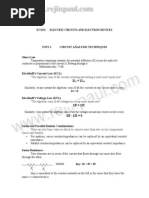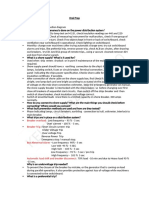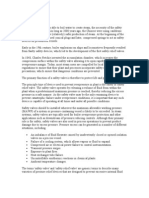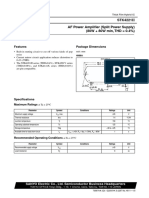Fault Analysis ECE4334
Fault Analysis ECE4334
Uploaded by
vthiyagainCopyright:
Available Formats
Fault Analysis ECE4334
Fault Analysis ECE4334
Uploaded by
vthiyagainOriginal Description:
Copyright
Available Formats
Share this document
Did you find this document useful?
Is this content inappropriate?
Copyright:
Available Formats
Fault Analysis ECE4334
Fault Analysis ECE4334
Uploaded by
vthiyagainCopyright:
Available Formats
ECE4334
Dr. C.Y. Evrenosoglu
ECE4334
FAULT ANALYSIS
Dr. E
ECE4334
Content
System representation
Single line-to-ground fault
Line-to-line fault
Double line-to-ground fault
Balanced (3) faults
Dr. C.Y. Evrenosoglu
ECE4334
System representation and assumptions
The power system operates under balanced steady-state conditions before
the fault occurs. Thus, the sequence networks are uncoupled before the
fault occurs. During unsymmetrical faults they are interconnected at the
fault location.
Prefault load current is neglected. This, prefault voltage, V
F
at the fault
point is close to its nominal value (i.e. it can be take to be 10). The
prefault voltage at each bus (and machine internal voltages) in the
positive-sequence network equals V
F
. This assumption is called flat
profile.
In defining the prefault flat voltage profile, we do take into account the
connection-induced phase shifts in Y xfmr.
Transformer winding resistances and shunt admittances are ignored.
Load impedances can be ignored
Series resistance and shunt elements in lines are ignored.
Armature resistance in generators is ignored.
The resulting circuit model consists only of sources and pure reactances.
Dr. C.Y. Evrenosoglu
ECE4334
Using symmetrical components
Dr. C.Y. Evrenosoglu
1
3
1 1 1
1
0
0
3
1
1
1
0
ECE4334
Using symmetrical components
Dr. C.Y. Evrenosoglu
ECE4334
Using symmetrical components
Dr. C.Y. Evrenosoglu
ECE4334
Example 9.1
Dr. C.Y. Evrenosoglu
ECE4334
Example 9.1
Dr. C.Y. Evrenosoglu
ECE4334
Example 9.2
Dr. C.Y. Evrenosoglu
At bus 2 all the voltages are 0!
ECE4334
Example 9.2
Dr. C.Y. Evrenosoglu
ECE4334
Single line-to-ground fault
Dr. C.Y. Evrenosoglu
1
3
1 1 1
1
0
0
3
1
1
1
3
ECE4334
Single line-to-ground fault
Dr. C.Y. Evrenosoglu
ECE4334
Single line-to-ground fault on the example
Dr. C.Y. Evrenosoglu
Remember?
ECE4334
Single line-to-ground fault on the example
Dr. C.Y. Evrenosoglu
Remember?
ECE4334
Single line-to-ground fault on the example
Dr. C.Y. Evrenosoglu
ECE4334
Single line-to-ground fault
Dr. C.Y. Evrenosoglu
ECE4334
Example 9.3
Dr. C.Y. Evrenosoglu
No fault impedance
ECE4334
REMEMBER: Example 9.1
Dr. C.Y. Evrenosoglu
ECE4334
REMEMBER: Example 9.1
Dr. C.Y. Evrenosoglu
ECE4334
Back to Example 9.3
Dr. C.Y. Evrenosoglu
ECE4334
Example 9.3
Dr. C.Y. Evrenosoglu
ECE4334
Line-to-line fault
Dr. C.Y. Evrenosoglu
1
3
1 1 1
1
3
0
1 1 1
1
ECE4334
Line-to-line fault
Dr. C.Y. Evrenosoglu
ECE4334
Line-to-line fault on the example
Dr. C.Y. Evrenosoglu
ECE4334
Line-to-line fault on the example
Dr. C.Y. Evrenosoglu
ECE4334
Example 9.4
Dr. C.Y. Evrenosoglu
ECE4334
Example 9.4
Dr. C.Y. Evrenosoglu
ECE4334
Double line-to-ground fault
Dr. C.Y. Evrenosoglu
1 1 1
1
ECE4334
Double line-to-ground fault
Dr. C.Y. Evrenosoglu
ECE4334
Double line-to-ground fault
Dr. C.Y. Evrenosoglu
ECE4334
Double line-to-ground fault on the example
Dr. C.Y. Evrenosoglu
ECE4334
Double line-to-ground fault on the example
Dr. C.Y. Evrenosoglu
ECE4334
Example 9.5
Dr. C.Y. Evrenosoglu
ECE4334
Example 9.5 (a,b)
Dr. C.Y. Evrenosoglu
ECE4334
Example 9.5 (a,b)
Dr. C.Y. Evrenosoglu
ECE4334
Example 9.5 (c)
Dr. C.Y. Evrenosoglu
ECE4334
Example 9.5 (c)
Dr. C.Y. Evrenosoglu
ECE4334
Example 9.5 (c)
Dr. C.Y. Evrenosoglu
ECE4334
Example 9.5 (c)
Dr. C.Y. Evrenosoglu
ECE4334
Example 9.6
Dr. C.Y. Evrenosoglu
ECE4334
REMEMBER: Example 9.1
Dr. C.Y. Evrenosoglu
ECE4334
Example 9.6
Dr. C.Y. Evrenosoglu
ECE4334
Example 9.6
Dr. C.Y. Evrenosoglu
ECE4334
Example 9.6
Dr. C.Y. Evrenosoglu
ECE4334
Example 9.6
Dr. C.Y. Evrenosoglu
ECE4334
Example 9.6
Dr. C.Y. Evrenosoglu
Results by ignoring
the xfmr shifts
ECE4334
Generalized solution for networks
Assume that we know the pre-fault voltages (solution
of power flow)
The general procedure is given as follows:
1. Calculate Z
bus
for each sequence (first calculate
Y
bus
)
2. For a fault at bus i, the Z
ii
values are the Thvenin
equivalent impedances; the pre-fault voltage is the
positive sequence Thvenin voltage.
3. Connect and solve the Thvenin equivalent
sequence networks to determine the fault currents
in each sequence.
Dr. C.Y. Evrenosoglu
Thanks to Dr. Tom Overbye, University of Illinois for the content
ECE4334
Generalized solution for networks
4. Sequence voltages throughout the system can be calculated by
5. Phase values are determined from the sequence values
Dr. C.Y. Evrenosoglu
Thanks to Dr. Tom Overbye, University of Illinois for the content
0
0
0
0
prefault
f
I
Z
= +
V V
M
M
This is solved
for each
sequence
network!
The entry
corresponds to the
faulted bus
ECE4334
Unbalanced fault example for a network
Pre-fault voltages are 1 pu at all buses. Pre-fault loads are ignored.
Transformer phase-shifts are ignored.
Calculate the bus voltages after a single-line-to-ground fault at bus
3.
Dr. C.Y. Evrenosoglu
ECE4334
Unbalanced fault example in network
First step: Sequence networks
Dr. C.Y. Evrenosoglu
ECE4334
Ex.: Positive/negative sequence networks
Dr. C.Y. Evrenosoglu
Form Y
bus
and subsequently calculate Z
bus
j0.2 j0.05
j0.2 j0.05
j0.1
j0.1 j0.1
24 10 10
10 24 10
10 10 20
0.1397 0.1103 0.1250
0.1103 0.1397 0.1250
0.1250 0.1250 0.1750
10 10
ECE4334
Ex.: Positive/negative sequence networks
Dr. C.Y. Evrenosoglu
Form Y
bus
and subsequently calculate Z
bus
j0.2 j0.05
j0.2 j0.05
j0.1
j0.1 j0.1
0.1397 0.1103 0.1250
0.1103 0.1397 0.1250
0.1250 0.1250 0.1750
Thvenin equivalent
impedance at bus 1
of positive & neg.
sequence networks
Thvenin equivalent
impedance at bus 2 Thvenin equivalent
impedance at bus 3
ECE4334
Ex.: Zero sequence network
Dr. C.Y. Evrenosoglu
Form Y
bus
and subsequently calculate Z
bus
j0.05 j0.05
j0.05 j0.05
j0.3
j0.3 j0.3
16.6667 3.3333 3.3333
3.3333 26.667 3.3333
3.3333 3.3333 20
0.0714 0.0143 0.0429
0.0143 0.429 0.0286
0.0429 0.0286 0.1857
ECE4334
Ex.: Zero sequence network
Dr. C.Y. Evrenosoglu
Form Y
bus
and subsequently calculate Z
bus
j0.05 j0.05
j0.05 j0.05
j0.3
j0.3 j0.3
0.0714 0.0143 0.0429
0.0143 0.429 0.0286
0.0429 0.0286 0.1857
Thvenin equivalent
impedance at bus 1
of zero sequence
network
Thvenin equivalent
impedance at bus 2
Thvenin equivalent
impedance at bus 3
ECE4334
EX: Sequence networks
For a single-line-to-ground fault at bus 3 the Thvenin equivalent
impedances are used for bus 3 and since it is a bolted fault we do not have
3Z
f
in the final circuit.
Dr. C.Y. Evrenosoglu
10
0.1857
0.1750
0.1750
For SLG fault the
sequence networks
are connected in
series
ECE4334
EX: Calculate the sequence currents & voltages
Dr. C.Y. Evrenosoglu
10
0.1857 0.1750 0.1750
1.8667
1.8667
Bus voltages at each bus in each sequence:
0
0
0
0
0
0
ECE4334
EX: Calculate the sequence voltages
Dr. C.Y. Evrenosoglu
10
10
10
0.1397 0.1103 0.1250
0.1103 0.1397 0.1250
0.1250 0.1250 0.1750
0
0
1.8667
0.1397 0.1103 0.1250
0.1103 0.1397 0.1250
0.1250 0.1250 0.1750
0
0
1.8667
0.0714 0.0143 0.0429
0.0143 0.429 0.0286
0.0429 0.0286 0.1857
0
0
1.8667
ECE4334
EX: Calculate the sequence voltages
Dr. C.Y. Evrenosoglu
0.7667
0.7667
0.6733
0.2333
0.2333
0.3267
0.080
0.0533
0.3467
ECE4334
EX: Calculate the phase voltages at bus 1
Dr. C.Y. Evrenosoglu
0.7667
0.7667
0.6733
0.2333
0.2333
0.3267
0.080
0.0533
0.3467
1 1 1
1
1 1 1
1
0.08
0.7667
0.2333
0.45330
0.9328 111.82
0.9328111.82
ECE4334
EX: Calculate the phase voltages at bus 2
Dr. C.Y. Evrenosoglu
0.7667
0.7667
0.6733
0.2333
0.2333
0.3267
0.080
0.0533
0.3467
1 1 1
1
1 1 1
1
0.0533
0.7667
0.2333
0.480
0.9233 110.28
0.9233110.28
ECE4334
EX: Calculate the phase voltages at bus 3
Dr. C.Y. Evrenosoglu
0.7667
0.7667
0.6733
0.2333
0.2333
0.3267
0.080
0.0533
0.3467
1 1 1
1
1 1 1
1
0.08
0.7667
0.2333
0
1.0101 120.98
1.0101120.98
ECE4334
What about faults on lines?
The previous analysis has assumed that the
fault is at a bus. Most faults occur on
transmission lines, not at the buses.
These faults are treated by including a
dummy bus at the fault location. How the
impedance of the transmission line is then
split depends upon the fault location.
Dr. C.Y. Evrenosoglu
Thanks to Dr. Tom Overbye, University of Illinois for the content
ECE4334
Power system protection
Main idea is to remove faults as quickly as
possible while leaving as much of the system as
intact as possible
Fault sequence of events
1. Fault occurs somewhere on the system, changing the
system currents and voltages
2. Current transformers (CTs) and potential transformers
(PTs) sensors detect the change in currents/voltages
3. Relays use sensor input to determine whether a fault
has occurred
4. When a fault occurs the relays open the circuit
breakers to isolate fault
Dr. C.Y. Evrenosoglu
Thanks to Dr. Tom Overbye, University of Illinois for the content
ECE4334
Power system protection
Protection systems must be designed with both
primary protection and backup protection in
case primary protection devices fail.
In designing power system protection systems
there are two main types of systems that need to be
considered:
1. Radial: there is a single source of power, so power
always flows in a single direction; this is the easiest
from a protection point of view
2. Network: power can flow in either direction:
protection is much more complicated
Dr. C.Y. Evrenosoglu
Thanks to Dr. Tom Overbye, University of Illinois for the content
You might also like
- 400KV Protection PDFDocument140 pages400KV Protection PDFvthiyagain100% (2)
- Cuadro de Comando Sigma Iris NVDocument20 pagesCuadro de Comando Sigma Iris NVJesus Checa100% (3)
- Per Unit SystemDocument11 pagesPer Unit SystemKyla BelgadoNo ratings yet
- Script For EcgDocument14 pagesScript For EcgMonesa Badil LingasaNo ratings yet
- Electrosurgical Units (ESU)Document22 pagesElectrosurgical Units (ESU)Anonymous CbchZO3hNo ratings yet
- 450.27 - NFPA 70 (2017) National Electrical Code® HandbookDocument1 page450.27 - NFPA 70 (2017) National Electrical Code® HandbookvthiyagainNo ratings yet
- AC DC AcDocument3 pagesAC DC AcPhani KumarNo ratings yet
- (McCormick) - Ocean Engineering Wave MechanicsDocument101 pages(McCormick) - Ocean Engineering Wave MechanicsMochamad Aji PamungkasNo ratings yet
- Lecture4 Power Flow AnalysisDocument0 pagesLecture4 Power Flow AnalysisfpttmmNo ratings yet
- Power Systems Elements LinesDocument80 pagesPower Systems Elements LinesJohan TadlasNo ratings yet
- Transformer ConstructionDocument46 pagesTransformer ConstructionSnr Berel ShepherdNo ratings yet
- Ecg (Ekg) ScriptDocument47 pagesEcg (Ekg) ScriptJojić Ivan100% (1)
- Lecture 5 Module 2Document14 pagesLecture 5 Module 2nikhil vNo ratings yet
- Laboratory Experiment 1 - Gonzales-ZairusDocument8 pagesLaboratory Experiment 1 - Gonzales-Zairuszairus gonzalesNo ratings yet
- Lighting Circuit: ECL 015ADocument3 pagesLighting Circuit: ECL 015AAdrianNo ratings yet
- Electrosurgery 2Document49 pagesElectrosurgery 2Nguyễn Thành100% (1)
- Tomcotechtips: Egr Valve Position SensorsDocument4 pagesTomcotechtips: Egr Valve Position Sensorstipo3331No ratings yet
- Basics of Electrical EngineeringDocument37 pagesBasics of Electrical Engineeringlp mishraNo ratings yet
- 11 ELC4340 Spring13 Short CircuitsDocument26 pages11 ELC4340 Spring13 Short Circuitsم. دخيل القحطانيNo ratings yet
- Ohm's Law, Power, and EnergyDocument80 pagesOhm's Law, Power, and EnergyDominique Tuble EcleoNo ratings yet
- 3phase Ccts - PPDocument46 pages3phase Ccts - PPdocs miNo ratings yet
- 1.2.4.A CircuitCalculationsDocument5 pages1.2.4.A CircuitCalculationsCarolay Gabriela Aponte RodriguezNo ratings yet
- Physics ProjectDocument11 pagesPhysics Projectsandysahishnu211107No ratings yet
- Non-Contact Heart Rate Variability Monitoring Using Doppler Radars Located Beneath Bed Mattress A Case ReportDocument5 pagesNon-Contact Heart Rate Variability Monitoring Using Doppler Radars Located Beneath Bed Mattress A Case ReportzhangsanNo ratings yet
- Fault Analysis: V V V I I IDocument10 pagesFault Analysis: V V V I I IEudes DamascenoNo ratings yet
- Zero Sequence Impedance CalculationDocument24 pagesZero Sequence Impedance Calculationaocalay100% (2)
- Module 5.1Document37 pagesModule 5.1JASPER PAYAPAYANo ratings yet
- Unit-I Circuit Analysis Techniques: Ec2151 Electric Circuits and Electron DevicesDocument34 pagesUnit-I Circuit Analysis Techniques: Ec2151 Electric Circuits and Electron Devicesaishuvc1822No ratings yet
- Exp 306Document7 pagesExp 306Kristianne Mae EchavezNo ratings yet
- Zero SequenceDocument3 pagesZero SequenceDinesh SelvakumarNo ratings yet
- Lec 3Document30 pagesLec 3belalallashyNo ratings yet
- Investigating the Relationship Between Voltage Ratios and Coil Turns in a TransformerDocument21 pagesInvestigating the Relationship Between Voltage Ratios and Coil Turns in a TransformerbajirafNo ratings yet
- 2140201lecture03 Node VoltageAnalysisDocument31 pages2140201lecture03 Node VoltageAnalysissuperpeNo ratings yet
- GIU_2643_64_19838_2024-10-02T13_52_34Document7 pagesGIU_2643_64_19838_2024-10-02T13_52_34ahmedcora72No ratings yet
- Circuit Theories RevisionDocument42 pagesCircuit Theories Revisionzhanzhao12345No ratings yet
- تجارب دوائر كاملةDocument14 pagesتجارب دوائر كاملةⲎⴑGⲎNo ratings yet
- Lab 1: Transformer 1Document2 pagesLab 1: Transformer 1NasirAbbasNo ratings yet
- 1.105 Solid Mechanics Laboratory Fall 2003: Experiment 6 The Linear, Elastic Behavior of A BeamDocument7 pages1.105 Solid Mechanics Laboratory Fall 2003: Experiment 6 The Linear, Elastic Behavior of A Beamprieten20006936No ratings yet
- Electrodardiogram (Ecg)Document9 pagesElectrodardiogram (Ecg)Abd Aziz MuhaiminNo ratings yet
- ECE340D chapter 5 part II print (2)Document73 pagesECE340D chapter 5 part II print (2)suhaasNo ratings yet
- 02 Linear Circuit AnalysisDocument29 pages02 Linear Circuit AnalysisAhsan MalikNo ratings yet
- Lec. 4Document33 pagesLec. 4mohamed tawfikNo ratings yet
- Form 3 W10Document15 pagesForm 3 W10memeawNo ratings yet
- UIC BioE 431 Instrumentation LabDocument71 pagesUIC BioE 431 Instrumentation LabSimisola OludareNo ratings yet
- Power Generation Footstep - 2Document5 pagesPower Generation Footstep - 2gideykibrom80No ratings yet
- 1 Power System Components and Per Unit SystemDocument8 pages1 Power System Components and Per Unit SystemsolimanNo ratings yet
- DOC-20241210-WA0007.Document19 pagesDOC-20241210-WA0007.lony9304No ratings yet
- Advances in UHV Transmission and DistributionDocument24 pagesAdvances in UHV Transmission and DistributionsalehknNo ratings yet
- WWW Eit Edu AuDocument62 pagesWWW Eit Edu AuSidhartha MallickNo ratings yet
- Electro Surgical UnitDocument7 pagesElectro Surgical UnitBikram MajhiNo ratings yet
- Lecture 06Document12 pagesLecture 06mmnnaayy98No ratings yet
- Investigating the Relationship Between Voltage Ratios and Coil Turns in a TransformerDocument17 pagesInvestigating the Relationship Between Voltage Ratios and Coil Turns in a TransformerbajirafNo ratings yet
- Beam To SHS ColumnDocument8 pagesBeam To SHS ColumnAli KhalafNo ratings yet
- ECED Revision 3Document3 pagesECED Revision 3jayj_5No ratings yet
- Sprawozdanie 51Document6 pagesSprawozdanie 51Angelika PaluchNo ratings yet
- Force Plates: Pressure TransducerDocument9 pagesForce Plates: Pressure Transduceramit_pt021No ratings yet
- Ultrasound Machine EMA (1)Document35 pagesUltrasound Machine EMA (1)tahaabdomohammedNo ratings yet
- Ecg Eeg EmgDocument16 pagesEcg Eeg EmgNeha100% (1)
- Eto Coc Oral QuestionsDocument26 pagesEto Coc Oral QuestionsRavi Pipariya100% (1)
- ECEG 6071 Chapter 3Document67 pagesECEG 6071 Chapter 3adman13031991No ratings yet
- Electrical Machine 1 PCEE 514 Lab ManualDocument41 pagesElectrical Machine 1 PCEE 514 Lab Manualpitileb810No ratings yet
- Human Factors Engineering IE 442: Laboratory ManualDocument5 pagesHuman Factors Engineering IE 442: Laboratory Manualoscar cienciaNo ratings yet
- BK Precision 1660Document48 pagesBK Precision 1660JabrokaNo ratings yet
- (Practical) ECGDocument7 pages(Practical) ECGmeewhayNo ratings yet
- Gigabit Ethernet 19' Switch, 2-20 Ports, Ports On Rear - AFS675-Ercpaaaaaaaauaeepzzx08.0Document7 pagesGigabit Ethernet 19' Switch, 2-20 Ports, Ports On Rear - AFS675-Ercpaaaaaaaauaeepzzx08.0vthiyagainNo ratings yet
- IMS - LANTIME M1000: Time and Frequency Synchronization Platform in 1U Rackmount-EnclosureDocument14 pagesIMS - LANTIME M1000: Time and Frequency Synchronization Platform in 1U Rackmount-EnclosurevthiyagainNo ratings yet
- Gateway Computer-ACP-4340Document12 pagesGateway Computer-ACP-4340vthiyagainNo ratings yet
- Full Gigabit Ethernet Switch L2 Software 16 Ports - Ports On Rear - AFS677-ER16CPZZX08.0Document8 pagesFull Gigabit Ethernet Switch L2 Software 16 Ports - Ports On Rear - AFS677-ER16CPZZX08.0vthiyagainNo ratings yet
- Andeli Fuse e 2012 12 19 15 56 42 437313Document1 pageAndeli Fuse e 2012 12 19 15 56 42 437313vthiyagainNo ratings yet
- AC To DC Power Conversion IEEEDocument40 pagesAC To DC Power Conversion IEEEvthiyagainNo ratings yet
- Manufacturer ReportDocument602 pagesManufacturer ReportvthiyagainNo ratings yet
- Calculation of Non Linear Resistor (Al Hassa Housing 115Kv/13.8Kv S/S)Document7 pagesCalculation of Non Linear Resistor (Al Hassa Housing 115Kv/13.8Kv S/S)vthiyagainNo ratings yet
- Balanced Fault Calculation PDFDocument79 pagesBalanced Fault Calculation PDFvthiyagainNo ratings yet
- Direct Torque Control: Technical Guide No. 1Document32 pagesDirect Torque Control: Technical Guide No. 1vthiyagain100% (1)
- IEEE Tutorial Sag Tension CalculationDocument33 pagesIEEE Tutorial Sag Tension CalculationvthiyagainNo ratings yet
- Differential ProtectionDocument19 pagesDifferential ProtectionvthiyagainNo ratings yet
- Chapter 12Document42 pagesChapter 12biotech_vidhyaNo ratings yet
- Ferro ResonanceDocument99 pagesFerro Resonancevthiyagain100% (1)
- 2 - Long Rod InsulatorsDocument1 page2 - Long Rod InsulatorsvthiyagainNo ratings yet
- CCVT and CC Instruction ManualDocument24 pagesCCVT and CC Instruction ManualvthiyagainNo ratings yet
- Pneumatic Sheet Cutting Machine: A Project Report OnDocument14 pagesPneumatic Sheet Cutting Machine: A Project Report OnKapil SharmaNo ratings yet
- 3rd Periodic Exam in Physics Answer KeyDocument3 pages3rd Periodic Exam in Physics Answer KeyMelvin CabonegroNo ratings yet
- Deisgn of CaissonDocument200 pagesDeisgn of CaissonAdol FirdausNo ratings yet
- Electromagnetic Sensing ElementsDocument14 pagesElectromagnetic Sensing ElementsSumit PatraNo ratings yet
- Controlled-Current: ConverterDocument7 pagesControlled-Current: ConverterRamphani NunnaNo ratings yet
- The Hunt For Earth Gravity: A History of Gravity Measurement From Galileo To The 21st Century John Milsom 2024 Scribd DownloadDocument62 pagesThe Hunt For Earth Gravity: A History of Gravity Measurement From Galileo To The 21st Century John Milsom 2024 Scribd Downloadaquwbaggo100% (3)
- Understanding Variable Speed Drives (Part 1)Document4 pagesUnderstanding Variable Speed Drives (Part 1)geav25653855No ratings yet
- G12 Physics Chapter 1 Full Tidy 2024 2025Document162 pagesG12 Physics Chapter 1 Full Tidy 2024 2025Somali YOS online FadityareNo ratings yet
- Power Electr CoDocument2 pagesPower Electr CoAmos KormeNo ratings yet
- DPP - 02 - Fluid NJ - 247Document3 pagesDPP - 02 - Fluid NJ - 247Suryansh TomarNo ratings yet
- Ferroresonance During Single-Phase Switching of Distribution TransformersDocument6 pagesFerroresonance During Single-Phase Switching of Distribution TransformersDiego Betancourt MejiaNo ratings yet
- Cataglog - MCB - Acti9 IC60N Katalog IndonesiaDocument3 pagesCataglog - MCB - Acti9 IC60N Katalog IndonesiaNelyana UnoNo ratings yet
- PerkinsDocument2 pagesPerkinsJacques Van NiekerkNo ratings yet
- LECTURE Earthquake EngineeringDocument9 pagesLECTURE Earthquake EngineeringIstian LammawinNo ratings yet
- Experiment 3 (Archimedes Principle)Document3 pagesExperiment 3 (Archimedes Principle)shark eyeNo ratings yet
- Safety Valve IntroductionDocument88 pagesSafety Valve Introductionbhuvi_patu12100% (3)
- 2C X 95CU POWER - Revised Datasheet Solar CableDocument1 page2C X 95CU POWER - Revised Datasheet Solar CableAashish MoyalNo ratings yet
- Electromagnetic - Launch For Space VehiclesDocument11 pagesElectromagnetic - Launch For Space Vehiclesbring it onNo ratings yet
- AWP Unit 5 Sky Wave PropagationDocument48 pagesAWP Unit 5 Sky Wave Propagationjenath1100% (1)
- CE211 Quiz #1 - Question With Solutions - Monday 4th March 2024Document2 pagesCE211 Quiz #1 - Question With Solutions - Monday 4th March 2024Dokta UrameNo ratings yet
- STK4221 AF Power Amplifier (Split Power Supply) (80W + 80W Min, THD 0.4%)Document6 pagesSTK4221 AF Power Amplifier (Split Power Supply) (80W + 80W Min, THD 0.4%)Vitorio LogoNo ratings yet
- June 2018 (R) MS - Paper 1P Edexcel Physics IGCSEDocument21 pagesJune 2018 (R) MS - Paper 1P Edexcel Physics IGCSEKaung Myat KyawNo ratings yet
- Core of Transformer and Design of Transformer Core - Electrical4uDocument8 pagesCore of Transformer and Design of Transformer Core - Electrical4uSulekh SharmaNo ratings yet
- Lab Sheet Djj5113Document27 pagesLab Sheet Djj5113Munisprasad MuniandyNo ratings yet
- Why Are Transformer and Alternator Ratings in KVA On ShipsDocument18 pagesWhy Are Transformer and Alternator Ratings in KVA On Shipsravi_92No ratings yet
- Auto Re CloseDocument19 pagesAuto Re Closeprateek43513100% (1)
- Problem 1:: Concepts, Principles, Relations That Apply To The ProblemDocument6 pagesProblem 1:: Concepts, Principles, Relations That Apply To The ProblemVishal GoyalNo ratings yet











































































































